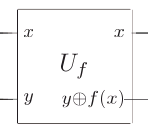
corresponding to the circuit diagram ([1], page 31):

These descriptions are correct if x,y ∈ {0,1}. But if x and/or y are superpositions then these descriptions may be misleading, and in particular the input x may not pass through Uf unchanged due to interference between the qubits.
Note that the ⊕ operation and function f(x) can only be applied directly to {0,1} operand values. For superpositions the operations are applied separately to each part.
In general we have:
| Uf |x, y> | = | |Ψ> |
| = | |w, z> if separable |
Consider the CNOT operation, so f(x) = x and Uf performs y⊕x.
If |x> = |0> + |1> and |y> = |0> - |1> then (leaving out some factors of 1/sqrt(2)):
| CNOT |x, y> | = | |0> (|0⊕0> - |1⊕0>) + |1> (|0⊕1> - |1⊕1>) |
| = | |0> (|0> - |1>) + |1> (|1> - |0>) | |
| = | |0> (|0> - |1>) - |1> (|0> - |1>) | |
| = | (|0> - |1>) (|0> - |1>) | |
| = | |w, y> |
So |x> is changed to |w> = |0> - |1> and y is unchanged.
In this case the action of operating on y with f(x) changes x and does not affect y.
This effect is due only to interference between the qubits. There is no entanglement as the result is separable into a product state.
For comparison, entanglement would occur using inputs |x> = |0> + |1> and |y> = |0>:
| CNOT |x, y> | = | |0> |0⊕0> + |1> |0⊕1> |
| = | |0> |0> + |1> |1> |
The state |00> + |11> is entangled and can not be factored into a product state.
An amplitude table for |w,z> = CNOT |x,y> is constructed by setting w=x and z=x⊕y.
Leaving out some factors of 1/sqrt(2), the initialization |x> = |0> + |1> and |y> = |0> - |1> corresponds to:
Letting a represent amplitude in the table,
with input amplitudes q and output amplitudes r:
CNOT: z = x⊕y
x y a -> x z a = x y a
q[0] 0 0 1 0 0 1 0 0 1 r[0] = q[0]
q[1] 0 1 -1 0 1 -1 0 1 -1 r[1] = q[1]
q[2] 1 0 1 1 1 1 \/ 1 0 -1 r[2] = q[3]
q[3] 1 1 -1 1 0 -1 /\ 1 1 1 r[3] = q[2]
Effectively, CNOT simply swaps the amplitudes of states |10> and |11>.
Although the table was constructed by explicitly replacing y with x⊕y, the result is the same as described above for interference, where x is changed and y is unchanged, which has amplitudes:
For comparison, the amplitude table for entanglement, with
initialization |x> = |0> + |1> and |y> = |0>, is:
CNOT: z = x⊕y
x y a -> x z a = x y a
q[0] 0 0 1 0 0 1 0 0 1 r[0] = q[0]
q[1] 0 1 0 0 1 0 0 1 0 r[1] = q[1]
q[2] 1 0 1 1 1 1 \/ 1 0 0 r[2] = q[3]
q[3] 1 1 0 1 0 0 /\ 1 1 1 r[3] = q[2]
[1] Quantum Computation and Quantum Information, 10th Anniversary Edition, Michael A. Nielsen & Isaac L. Chuang, Cambridge University Press, 2010.